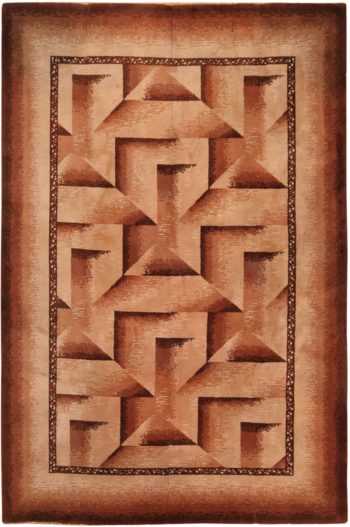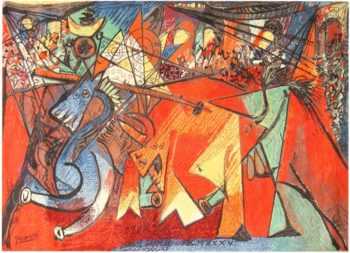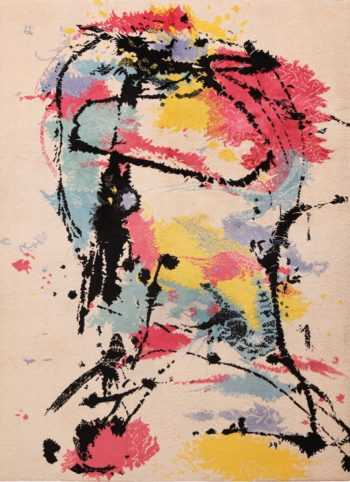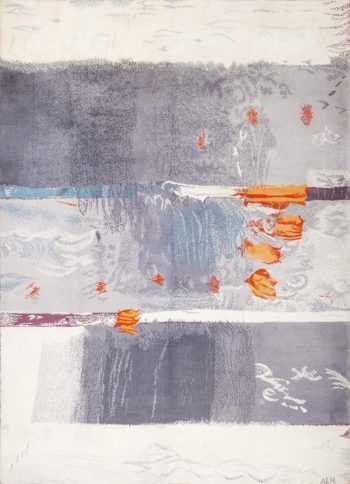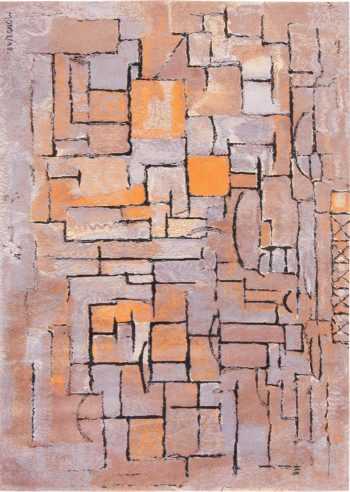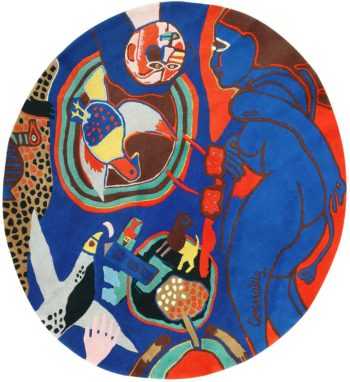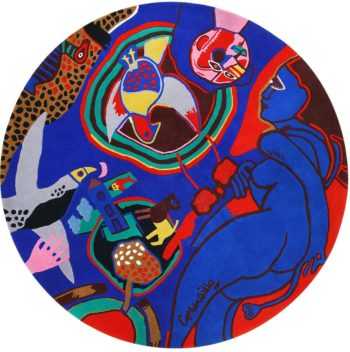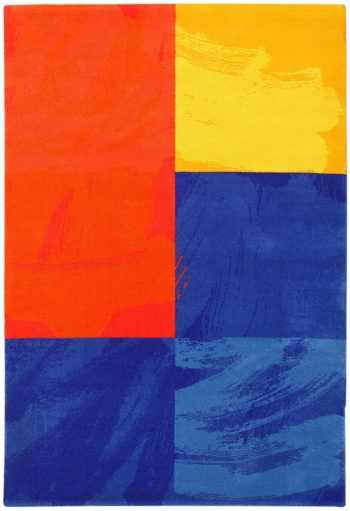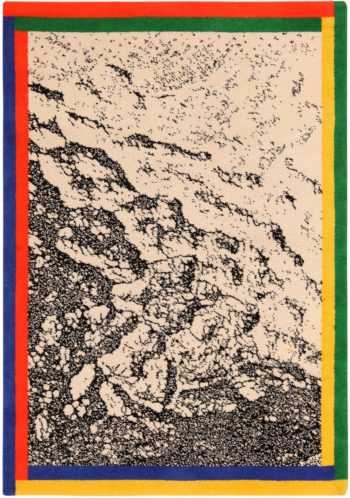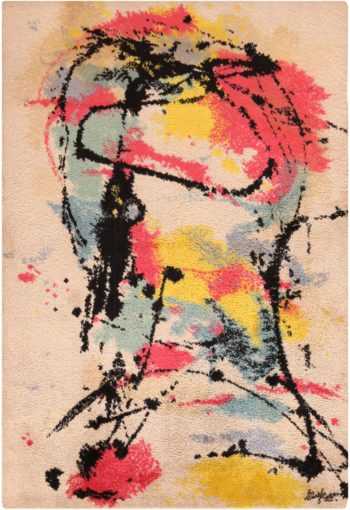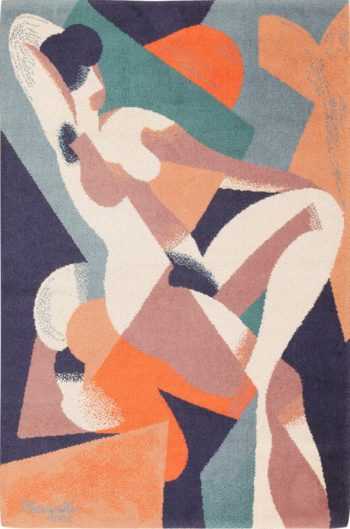Machine Made Rugs
View the entire collection of Machine Made Rugs:
-
Art Deco Design Wilton Rug 70074
$19,500.00Size: 8 ft 10 in x 13 ft 5 in (2.69 m x 4.09 m) -
Vintage Ege Pablo Picasso Run Of The Bulls Rug 47991
$14,750.00Size: 8 ft 2 in x 11 ft 2 in (2.49 m x 3.4 m) -
Vintage Swedish Robert Jacobsen Ege Rug 70077
$16,500.00Size: 8 ft x 11 ft (2.44 m x 3.35 m) -
Vintage Scandinavian Ege Art Line Robert Jacobsen Rug 49670
$14,000.00Size: 8 ft 2 in x 11 ft (2.49 m x 3.35 m) -
Vintage Swedish Ege Art Rug Based On Arne L Hansen Painting 49215
$12,500.00Size: 8 ft 2 in x 11 ft (2.49 m x 3.35 m) -
Scandinavian Rug after Piet Mondrian 47630
$18,500.00Size: 8 ft x 11 ft (2.44 m x 3.35 m) -
Vintage Round Corneille Art Rug 48332
$9,500.00Size: 7 ft 2 in x 7 ft 2 in (2.18 m x 2.18 m) -
Mid Century Vintage Round Corneille Rug 48201
$9,500.00Size: 7 ft 2 in x 7 ft 2 in (2.18 m x 2.18 m) -
Square Vintage Scandinavian Surrealist Tapestry Rug by Corneille 49544
$9,500.00Size: 6 ft 10 in x 6 ft 10 in (2.08 m x 2.08 m) -
Vintage Scandinavian Per Arnoldi Art Rug by Ege 48121
$5,750.00Size: 4 ft 8 in x 6 ft 9 in (1.42 m x 2.06 m) -
Vintage Scandinavian Ege Art Rug Named “Hurricane” 71697
$3,900.00Size: 4 ft 7 in x 6 ft 8 in (1.4 m x 2.03 m) -
Vintage Swedish Robert Jacobsen Ege Artistic Rug 71696
$3,900.00Size: 4 ft 6 in x 6 ft 7 in (1.37 m x 2.01 m) -
Vintage Scandinavian Rug by René Magritte 47671
$3,650.00Size: 4 ft 7 in x 6 ft 7 in (1.4 m x 2.01 m) -
Vintage Scandinavian Corneille Art Rug 49578
$5,750.00Size: 9 ft x 6 ft (2.74 m x 1.83 m)
Learning More About Machine Made Rugs
Click here to read about how rugs & carpets are made
What is a machine made rug?
A machine-made rug refers to a rug that is produced using automated machinery, typically using power looms or other mechanical weaving processes. Unlike handmade rugs, which are crafted by skilled artisans using traditional weaving techniques, machine-made rugs are manufactured in a more automated and efficient manner.
Here are some key characteristics of machine-made rugs:
- Manufacturing Process: Machine-made rugs are woven on automated looms that are powered by machines. The weaving process is mechanized and controlled by computers or other systems, allowing for faster and more consistent production.
- Materials: Machine-made rugs can be crafted from a variety of materials, including synthetic fibers like nylon, polyester, or polypropylene, as well as natural fibers such as wool or cotton. The choice of materials depends on the desired characteristics of the rug, such as durability, softness, or affordability.
- Consistency: One of the advantages of machine-made rugs is the consistency in pattern and design. The automated process ensures that each rug produced is nearly identical to the next, providing a uniform appearance across a large batch.
- Affordability: Machine-made rugs are often more affordable than handmade rugs. The automated production process allows for cost savings in terms of labor and time, making these rugs accessible to a broader range of consumers.
- Wide Availability: Machine-made rugs are mass-produced, leading to a wide availability of designs, styles, and sizes. This makes it easier for consumers to find rugs that suit their preferences and fit specific spaces within their homes.
- Quick Production: The automated nature of the manufacturing process enables quick production of machine-made rugs. This is in contrast to handmade rugs, which can take a much longer time to produce due to the intricate craftsmanship involved.
- Various Styles: Machine-made rugs can be found in a variety of styles, ranging from traditional and oriental patterns to modern and contemporary designs. The versatility in styles caters to diverse consumer preferences.
While machine-made rugs may lack the individuality and artisanal touch of handmade rugs, they offer practical advantages such as affordability, consistency, and a wide range of options.
The choice between machine-made and handmade rugs often depends on personal preferences, budget considerations, and the intended use of the rug in a given space.
Why do people source rugs made by machines vs area rugs made by hand?
People may choose machine-made rugs over handmade area rugs for several reasons, and the decision often depends on individual preferences, budget considerations, and specific needs.
Here are some common reasons why individuals may opt for machine-made rugs:
- Affordability: Machine-made rugs are generally more affordable than handmade rugs. The automated production process reduces labor costs, making machine-made rugs a cost-effective option for individuals on a budget.
- Consistency: Machine-made rugs offer a high level of consistency in terms of pattern, design, and size. Each rug produced by a machine is nearly identical to the next, providing a uniform appearance. This consistency can be important when trying to achieve a cohesive look in a space.
- Wide Variety: Machine-made rugs come in a wide variety of styles, colors, and patterns. The mass production allows for a diverse range of options, making it easier for consumers to find a rug that suits their specific taste and complements their decor.
- Availability: Machine-made rugs are readily available in many retail outlets, both in-store and online. The widespread availability makes it convenient for consumers to find and purchase rugs that meet their requirements without the need for custom orders or long waiting times.
- Durability: Depending on the materials used, machine-made rugs can be durable and resistant to wear and tear. Synthetic fibers such as nylon or polypropylene are often used in machine-made rugs, providing durability and resistance to stains.
- Practical Use: Machine-made rugs are suitable for high-traffic areas and spaces where practicality is a primary concern. They are easy to clean and maintain, making them a practical choice for households with children or pets.
- Quick Production: Machine-made rugs are produced quickly and efficiently, allowing consumers to acquire a rug for their space in a relatively short amount of time. This contrasts with the longer production times associated with handmade rugs.
- Modern Designs: Machine-made rugs often feature contemporary and modern designs that cater to current interior design trends. This appeals to individuals seeking a more contemporary or updated look in their living spaces.
While machine-made rugs offer practical benefits and accessibility, handmade rugs are valued for their uniqueness, craftsmanship, and often higher quality materials.
Ultimately, the choice between machine-made and handmade rugs depends on individual preferences, the desired aesthetic, and the budget available for the purchase. Some individuals may also choose to mix both types of rugs in different areas of their homes based on specific needs and style preferences.
What were some of the most famous machine rug makers?
Several companies have become renowned for their contributions to the production of machine-made rugs.
Some of the most famous machine rug makers include:
- Axminster Carpets: As mentioned earlier, the Axminster carpet factory in England is often credited with pioneering large-scale production of machine-woven carpets in the 19th century. Axminster Carpets is still a well-known brand today, producing a variety of carpets and rugs.
- Wilton Carpets: Wilton Carpets is another historic British company that played a significant role in the development of machine-made rugs. The Wilton loom, which they helped popularize, became a standard in the industry for producing high-quality woven carpets.
- Mohawk Industries: Mohawk Industries, based in the United States, is one of the largest flooring manufacturers globally. They produce a wide range of floor coverings, including machine-made rugs. Mohawk is known for its commitment to innovation and sustainability.
- Karastan: Karastan, a subsidiary of Mohawk Industries, is a well-known brand specializing in machine-made rugs. They are recognized for their high-quality carpets and rugs with intricate designs and durable materials.
- Oriental Weavers: Oriental Weavers is an Egyptian-based company and one of the world’s largest machine-made rug manufacturers. They produce a diverse range of rugs using various materials and designs.
- Couristan: Couristan is a prominent name in the world of machine-made and handmade rugs. The company, founded in 1926, has been a leader in producing stylish and durable floor coverings.
- Nourison Industries: Nourison is a leading global floor covering company that manufactures both handmade and machine-made rugs. They are known for their diverse range of designs and materials.
- Shaw Industries: Shaw Industries, part of Berkshire Hathaway, is one of the largest carpet manufacturers globally. They produce a variety of flooring products, including machine-made rugs, and are recognized for their commitment to sustainability.
These companies have left a lasting impact on the rug industry, combining traditional craftsmanship with modern manufacturing techniques to create high-quality and accessible floor coverings for a wide range of consumers.
When were the first “Machine made rugs” made?
The first machine-made rugs emerged during the Industrial Revolution in the 19th century. The development of power looms and other mechanized weaving technologies revolutionized the textile industry, including the production of rugs. One of the significant milestones in the history of machine-made rugs was the invention of the Jacquard loom in the early 1800s.
The Jacquard loom, invented by Joseph Marie Jacquard in 1804, used punched cards to control the pattern of the weave. This innovation allowed for more complex and intricate designs to be produced with greater speed and efficiency. As a result, the production of rugs transitioned from traditional hand weaving to machine weaving.
The first large-scale production of machine-made rugs is often attributed to the Axminster carpet factory in England. In 1835, the factory began producing machine-woven carpets using the Jacquard loom. This marked a significant shift in the rug industry, as machine-made rugs could be produced more quickly and in larger quantities than their handmade counterparts.
Subsequent advancements in technology, such as the Wilton loom and the power loom, further contributed to the growth of machine-made rug production. By the late 19th and early 20th centuries, machine-made rugs became widely available and accessible, catering to a broader market.
More about the machine made area rugs
Since the earliest days of western industrialization, beginning in the 19th century, many rugs have been manufactured (or mass-produced) by a wide variety of machine loom processes. Such area rugs – which are commonly referred to as “machine made rugs” – are generally made from the same materials as hand-made rugs. These include wool, silk, and high quality cotton, with a small number of pieces being woven from other materials.
In addition to an emphasis on high quality weaving materials, the standards of fabrication for machine made rugs may also be high. After all, machine made rugs are consumer-end products that are manufactured with the express purpose of selling a very large number of them. High quality weaving materials are important for mass-production, as they ensure fewer problems will arise during manufacture. However, this utilization of high quality materials is unfortunately the most that one can expect to celebrate about most machine made rugs, which are mechanical in their execution, and often in their design as well.
Machine made rugs are programmatic and contain no surprises, no idiosyncrasies, and none of the little bits of magic that add up to make a great hand-made rug. In other words, machine made rugs simply lack the personality that one finds in authentic hand made rugs.
As mass-produced items, machine made rugs are almost always less valuable than their hand-made counterparts, although there are some examples of machine made rugs, such as the perennially popular Wiltons or Karastans, that will command a high price. Of course, while cost is certainly an important factor, the most important distinction between machine made rugs and hand-made rugs is the simple and inescapable fact that hand-made rugs are almost always more expressive, more adventurous, and more exciting than machine-made rugs, which may be artful, but are not art the same way that hand-made rugs are.

A machine used for mass producing rugs.
Machine Made Rugs vs. Hand Knotted Rugs: Know the Difference
One of the questions that we often get is what makes a hand knotted carpet so special. An antique hand-knotted Persian carpet from the 18th century can cost thousands or even tens of thousands of dollars. Yet, you can get a carpet with a somewhat similar design for a few hundred dollars at a department store. There is often a big difference in price range between a hand knotted antique and a synthetic machine-made carpet. You may be wondering what justifies the price of the rug and whether it is worth it. Let’s explore what the differences really are.

Hand knotting a rug.
Look and Feel Of Machine-Made Rugs
In a side by side comparison, the beauty of the hand knotted carpet will stand out in contrast to the machine made rugs in a way that is obvious to the eye. Hand knotted carpets have colors produced from natural plants that blend in a way that synthetic dyes can never reproduce, even when using the same materials and colors. Authentic hand knotted carpets feel soft and plush. Synthetic fibers can only go so far in achieving softness, regardless of the pile type or structure.
With a hand knotted carpet, the design of the rug is produced by each of the knots being hand-tied individually. The weaver carefully places the colors according to a rug cartoon that serves as a reference pattern. Machine-made carpets are sometimes stamped after the carpet has been woven. The designs are stamped or painted on and are not an integral part of the weave. This is especially true when it comes to carpets with a low, uncut pile.
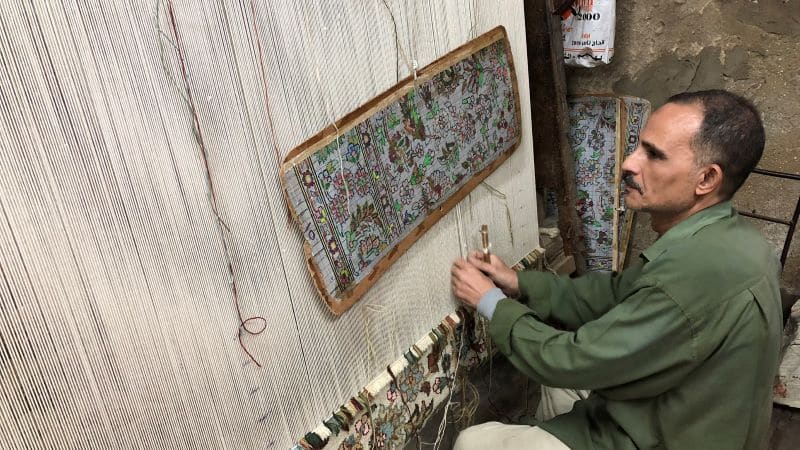
A man hand weaving on a loom using a rug cartoon.
The Speed of Machine-Made Rugs
One of the biggest differences between a hand knotted heirloom treasure and machine made rugs is the time and care that goes into it making it. A hand knotted rug takes months or even several years to produce. It is an intentional work of art. By comparison, machines can create carpets at a rate of about 200-250 woven rows per minute. This translates into about one and one-half inches per minute. A power loom can produce about seven to eight feet per hour. This means that in an eight-hour production day, one loom can produce about eight room-sized carpets. Many manufacturers have multiple looms in operation at a time.
By comparison, one fine, high knot count hand knotted carpet can take over a year to produce. Another significant difference is in the materials. Hand knotted carpets are made of natural fibers such as wool, silk, and cotton. Machine-made rugs are typically made of synthetic fibers such as nylon, acrylic, polyester, and imitation silk. They are dyed with synthetic, chemically-based dyes. It is easy to see the difference visually. If the carpet is hand knotted, the dyes will be even all the way through the pile. Synthetic carpets using chemical dyes will show fading at the open end of the pile and will be darker near the base. This is because chemical dyes break down quicker in the sunlight than properly dyed natural colors do.
Manufacturers of machine-made carpets work hard to develop techniques that mimic hand knotted carpets, but they can only come so close and can never match the beauty and artistry of an authentic hand knotted carpet. Many of the designs are computer-generated and based on Oriental rugs, but they have a mechanical look and feel that can be distinguished from a natural carpet.
Manufactured pile carpets are produced by using an automatic power loom, but sometimes, the pile is left as loops that are then cut all at once at the end of the process. With hand knotted carpets, the pile is cut as each individual knot is tied. A final trim is performed after the pile is complete.
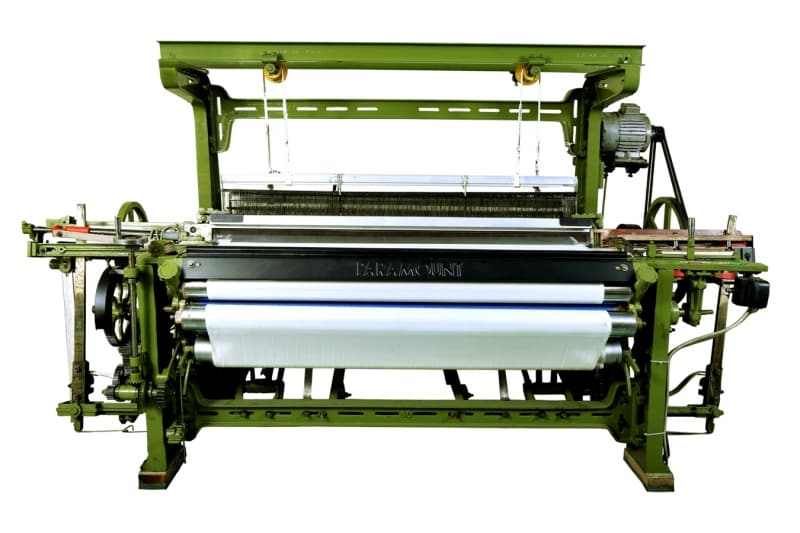
A power loom used for machine made rugs.
Spotting A Machine-Made Rug
One of the key differences between machine-made and hand knotted carpets is lifespan. Some hand-knotted carpets produced as far back as the 17th century still look as bright and beautiful as the day they were produced. You can expect a hand knotted carpet to last about 150 years or longer when given proper care. The best that you can expect to get from a machine-made carpet is about 20 years maximum. Synthetic materials are not as durable and break down under UV light quickly as compared to natural fibers.
From a collector’s standpoint, machine-made carpets have no value. Only an authentic hand-made carpet has value from an artistic and collectible standpoint. Unfortunately, some in the world will try to pass off a manufactured carpet as an authentic knotted one. It is especially important to be cautious in general marketplaces on the internet. There are many reputable dealers with authentic carpets out there, but you must be able to tell the difference. Fortunately, some telltale signs will be a giveaway that the carpet is manufactured, even when only the pictures are available.
1. Feel and texture.
Of course, if you can see the carpet in person, you can tell by texture and feel of the carpet. There are some relatively convincing synthetic materials available that may be difficult to spot at first. However, a synthetic fiber can never mimic the softness of wool or cotton. Artificial silk is quite soft and shiny, but it still cannot come close to the luster and feel of the real thing.
2. Look at the back.
If you cannot see the back of the carpet in person, pictures can tell you what you need to know. Some manufactured carpets have the pile sewn onto a backing. You will be able to see the lines of stitching in these carpets. Others are created with a power loom and the back and look quite similar to a hand knotted carpet. You will see little bumps where each knot was placed. With a hand knotted carpet these little bumps will be a bit unevenly spaced, and there may be little imperfections. In a manufactured carpet, these little bumps will be perfectly even without variation, as only a machine can produce.
3. Look for a backing material.
If the carpet has a rubber backing, it is a more than likely a machine made rug. If it has any other type of backing, it should be suspect of being manufactured. Some manufacturers will glue the stitches on the back to keep them in place. They will then cover the glue with some type of backing. To find a hand knotted pile carpet with a backing is exceptionally rare. The only time when a backing may be applied is if the piece is a valuable antique where a backing has been applied for historical preservation purposes.
4. Examine the edges.
Hand knotted carpets can have many different edging styles. These styles differ regionally. However, they are all some type of weaving. Machine made rugs may have binding applied to the edges, or they may have an overcast stitch applied. An overcast stitch may look like the serged edge that you find on clothing seams. A hand knotted carpet will not have one of these binding techniques applied.
5. Check the colors.
Sometimes, it can be difficult to tell if the colors of the rug are synthetic or natural dyed to the untrained eye. However, even a beginner can learn some telltale clues. Ask for a picture of the carpet front with the fabric bent to expose the pile. If the color fades at the tips of the pile, then it is probably synthetic. Even when natural fibers fade, they fade evenly across the length of the pile. One can find some bright happy jewel tone colors in authentic area rugs , but if you happen to see hot pink or fluorescent orange, it is most likely synthetic. Natural colors will always blend together in a way that is pleasing to the eye.
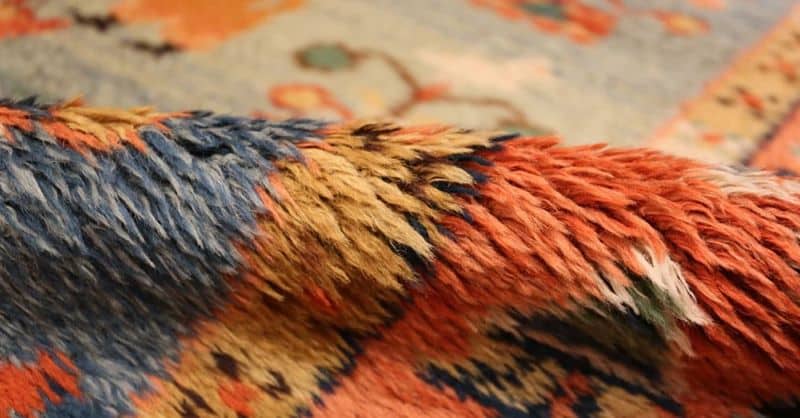
Examine the pile of the rug to see if it is machine-made.
Although you may be tempted to buy a cheap imitation of machine made rugs because of the price, there is nothing like the look and feel of a hand knotted rug. Each hand knotted rug is a work of art and a piece of the heart and soul of the weaver. Each piece is a deliberate creation and can take up to several years to complete. This love and care is something that a machine can never reproduce. Each hand knotted rug is the result of the artistic choices of the weaver, and a little bit of them is woven into each knot. The human touch is the most important part of an authentic Persian carpet.
Any reputable dealer will not hesitate to send you pictures of the edges, back, depth of pile, or any other photos of the carpet that you want to see. These pictures are worth a thousand words, and you should always be cautious of a person who hesitates to let you examine the carpet further, even if only through additional photos.
Nazmiyal Collection has been around since the 1980’s and has built a trusted reputation in the industry. Our selection of carpets includes many different styles and types. We are always happy to answer any questions that you may have on any of the carpets that you see, and if you find one that you are interested in, you can always ask for additional photos. You are encouraged to come and visit our gallery if you are in the New York City area and see these magnificent pieces for yourself.

